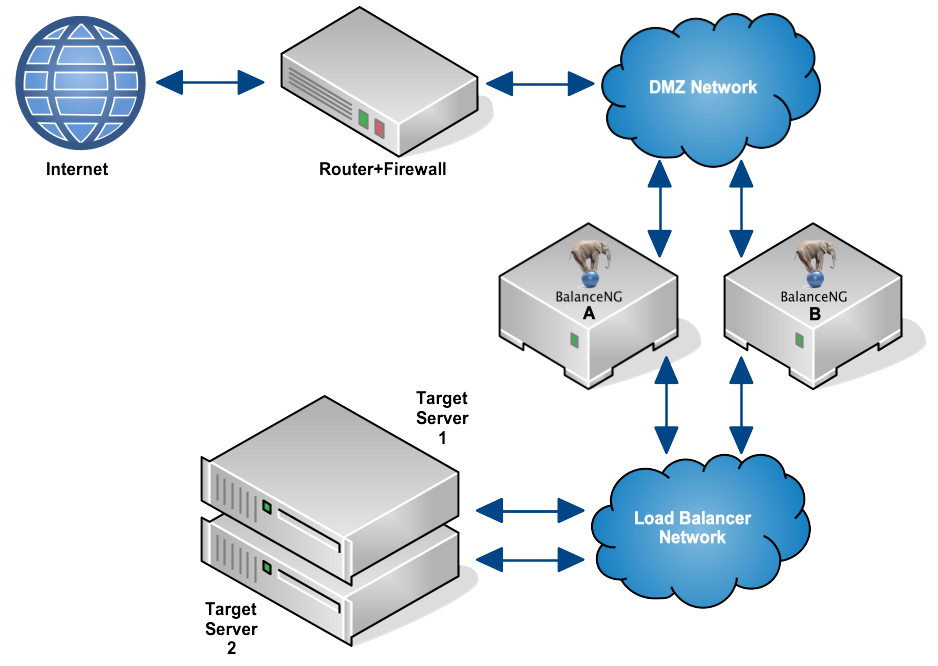2. Dual Legged Routing Mode Example
Dual Legged Routing Mode Network Overview
In this example we use exactly the same network settings as in Example 1, but instead of operating everything in one physical LAN, we establish a second, separate LAN for load balancing. Additionally, we are configuring two BalanceNG nodes with VRRP in order to achieve high availability.
The configuration then looks as this (switches not shown):

Network Configuration Overview - Dual legged Routing Mode
The Configuration Files
BalanceNG Node A
// configuration taken ...
// BalanceNG ...
modules vrrp,arp,ping,hc,master,slb,tnat,nat,rt
set ipforwarding 1
interface 1 {
name eth0
access raw
}
interface 2 {
name eth1
access raw
}
register interfaces 1,2
enable interface 1,2
vrrp {
vrid 71
priority 200
network 1
}
network 1 {
name "DMZ Network"
addr 172.16.1.0
mask 255.255.255.0
real 172.16.1.251
virt 172.16.1.253
nat outside
interface 1
}
network 2 {
name "LN Network"
addr 10.1.1.0
mask 255.255.255.0
real 10.1.1.252
virt 10.1.1.254
nat inside
interface 2
}
register networks 1,2
enable networks 1,2
gateway {
ipaddr 172.16.1.254
ping 3,8
}
server 1 {
ipaddr 172.16.1.10
port 80
protocol tcp
targets 1,2
}
register server 1
enable server 1
target 1 {
ipaddr 10.1.1.1
port 80
protocol tcp
tcpopen 80,3,10
}
target 2 {
ipaddr 10.1.1.2
port 80
protocol tcp
tcpopen 80,2,10
}
register targets 1,2
enable targets 1,2
// end of configuration
BalanceNG Node B
// configuration taken ...
// BalanceNG ...
modules vrrp,arp,ping,hc,master,slb,tnat,nat,rt
set ipforwarding 1
interface 1 {
name eth0
access raw
}
interface 2 {
name eth1
access raw
}
register interface 1,2
enable interface 1,2
vrrp {
vrid 71
priority 200
network 1
}
network 1 {
name "DMZ Network"
addr 172.16.1.0
mask 255.255.255.0
real 172.16.1.252
virt 172.16.1.253
nat outside
interface 1
}
network 2 {
name "LN Network"
addr 10.1.1.0
mask 255.255.255.0
real 10.1.1.253
virt 10.1.1.254
nat inside
interface 2
}
register networks 1,2
enable networks 1,2
gateway {
ipaddr 172.16.1.254
ping 3,8
}
server 1 {
ipaddr 172.16.1.10
port 80
protocol tcp
targets 1,2
}
register server 1
enable server 1
target 1 {
ipaddr 10.1.1.1
port 80
protocol tcp
tcpopen 80,3,10
}
target 2 {
ipaddr 10.1.1.2
port 80
protocol tcp
tcpopen 80,2,10
}
register targets 1,2
enable targets 1,2
// end of configuration
Testing
- You should be able to ping the default gateway 10.1.1.254 from the targets.
- You should be able to ping the virtual web server 172.16.1.10 from the router.
- Clients from the Internet are able to initiate TCP connection to port 80 on the virtual Web Server 172.16.1.10 (now being represented by BalanceNG). “show servers” and “show targets” in BalanceNG interactive mode should show everything up and operating.